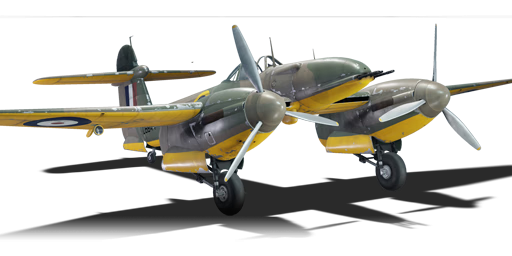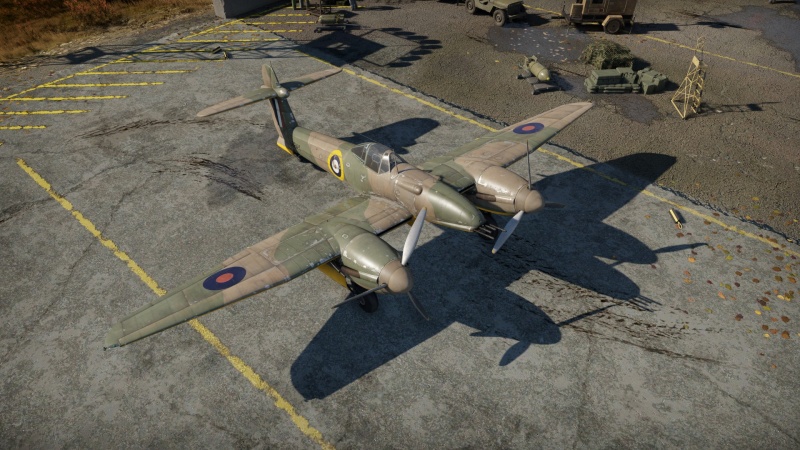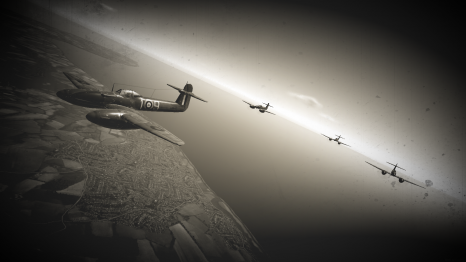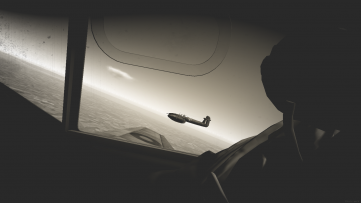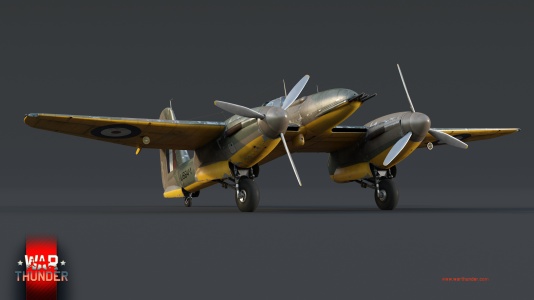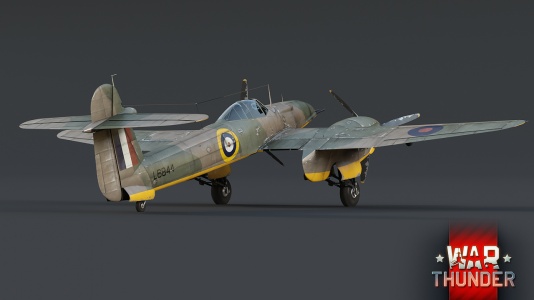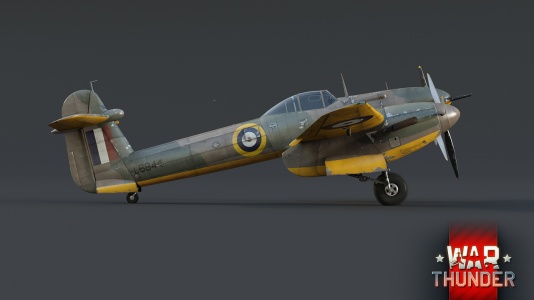Difference between revisions of "Whirlwind P.9"
(→Pros and cons: Edits) |
m (→Description: Added event link) |
||
| (36 intermediate revisions by 16 users not shown) | |||
| Line 1: | Line 1: | ||
| − | |||
| − | |||
| − | |||
| − | |||
{{About | {{About | ||
| about = British gift twin-engine fighter '''{{PAGENAME}}''' | | about = British gift twin-engine fighter '''{{PAGENAME}}''' | ||
| usage = the other version | | usage = the other version | ||
| link = Whirlwind Mk I | | link = Whirlwind Mk I | ||
| + | }} | ||
| + | {{Specs-Card | ||
| + | |code=whirlwind_p9 | ||
| + | |images={{Specs-Card-Image|GarageImage_{{PAGENAME}}.jpg}} | ||
| + | |market=Whirlwind P.9 (Britain) | ||
}} | }} | ||
== Description == | == Description == | ||
<!-- ''In the description, the first part should be about the history of and the creation and combat usage of the aircraft, as well as its key features. In the second part, tell the reader about the aircraft in the game. Insert a screenshot of the vehicle, so that if the novice player does not remember the vehicle by name, he will immediately understand what kind of vehicle the article is talking about.'' --> | <!-- ''In the description, the first part should be about the history of and the creation and combat usage of the aircraft, as well as its key features. In the second part, tell the reader about the aircraft in the game. Insert a screenshot of the vehicle, so that if the novice player does not remember the vehicle by name, he will immediately understand what kind of vehicle the article is talking about.'' --> | ||
| − | + | The '''{{Specs|name}}''' is a gift rank {{Specs|rank}} British twin-engine fighter {{Battle-rating}}. This aircraft was introduced in [[Update 1.77 "Advancing Storm"]] during the 2018 World War Two Chronicles. It was later re-released during [[Update 1.91 "Night Vision"]] as a reward for the [[wt:en/news/6409-special-operation-shipyard-en|2019 Operation "Shipyard"]] event. | |
| − | + | ||
| − | The '''{{Specs|name}}''' is a gift rank {{Specs|rank}} British twin-engine fighter {{Battle-rating}}. This aircraft was introduced in [[Update 1.77 "Advancing Storm"]] during the 2018 World War Two Chronicles. It was later | + | Whirlwind P.9, an experimental pre-production vehicle, is the direct ancestor of the British [[Whirlwind Mk I]] heavy fighter. Development of the aircraft began in 1937 and the aircraft in this series had plenty of time to fight against German aircraft and ships during the Battle of Britain. |
== General info == | == General info == | ||
=== Flight performance === | === Flight performance === | ||
| − | ''Describe how the aircraft behaves in the air. Speed, manoeuvrability, acceleration and allowable loads - these are the most important characteristics of the vehicle.'' | + | {{Specs-Avia-Flight}} |
| + | <!-- ''Describe how the aircraft behaves in the air. Speed, manoeuvrability, acceleration and allowable loads - these are the most important characteristics of the vehicle.'' --> | ||
| + | The Whirlwind is agile and speedy in level flight. The manoeuvrability is surprising, and even better with the use of flaps, making it possible to dogfight with most of the twin-engine fighters and, with skill and situational advantages, some single-engine planes as well. Just be wary of not draining all your speed while dogfighting enemies. | ||
| + | |||
| + | If played conservatively, this plane can be a tenacious opponent, especially when having an altitude advantage as this allows the {{PAGENAME}} to dive, fire, and then escape from enemies all with the same energy. This way a pilot can exploit the {{PAGENAME}}'s great speed to minimize the enemy's chance of getting a successful hit. | ||
| − | {| class="wikitable" style="text-align:center" | + | {| class="wikitable" style="text-align:center" width="70%" |
| − | + | ! rowspan="2" | Characteristics | |
| − | |||
| − | |||
| − | ! | ||
| − | |||
! colspan="2" | Max Speed<br>(km/h at 4,877 m) | ! colspan="2" | Max Speed<br>(km/h at 4,877 m) | ||
| − | ! rowspan="2" | Max altitude<br>( | + | ! rowspan="2" | Max altitude<br>(metres) |
! colspan="2" | Turn time<br>(seconds) | ! colspan="2" | Turn time<br>(seconds) | ||
| − | ! colspan="2" | Rate of climb<br>( | + | ! colspan="2" | Rate of climb<br>(metres/second) |
| − | ! rowspan="2" | Take-off run<br>( | + | ! rowspan="2" | Take-off run<br>(metres) |
|- | |- | ||
! AB !! RB !! AB !! RB !! AB !! RB | ! AB !! RB !! AB !! RB !! AB !! RB | ||
|- | |- | ||
| − | | | + | ! Stock |
| − | + | | 559 || 543 || rowspan="2" | {{Specs|ceiling}} || 24.2 || 25.1 || 12.2 || 12.2 || rowspan="2" | 650 | |
| − | |||
| − | |||
| − | |||
| − | |||
| − | |||
| − | |||
| − | |||
| − | |||
| − | |||
|- | |- | ||
| − | | 602 || 580 | + | ! Upgraded |
| + | | 602 || 580 || 21.9 || 23.0 || 18.2 || 15.0 | ||
|- | |- | ||
|} | |} | ||
==== Details ==== | ==== Details ==== | ||
| − | {| class="wikitable" style="text-align:center" | + | {| class="wikitable" style="text-align:center" width="50%" |
|- | |- | ||
! colspan="5" | Features | ! colspan="5" | Features | ||
| Line 60: | Line 53: | ||
|} | |} | ||
| − | {| class="wikitable" style="text-align:center" | + | {| class="wikitable" style="text-align:center" width="50%" |
|- | |- | ||
| − | ! colspan=" | + | ! colspan="7" | Limits |
|- | |- | ||
| − | ! rowspan="2" | | + | ! rowspan="2" | Wings (km/h) |
| − | ! rowspan="2" | Gear | + | ! rowspan="2" | Gear (km/h) |
| − | ! | + | ! colspan="3" | Flaps (km/h) |
! colspan="2" | Max Static G | ! colspan="2" | Max Static G | ||
|- | |- | ||
| − | ! + !! - | + | ! Combat !! Take-off !! Landing !! + !! - |
|- | |- | ||
| − | | {{Specs|destruction| | + | | {{Specs|destruction|body}} || {{Specs|destruction|gear}} || 465 || 433 || 265 || ~10 || ~5 |
|- | |- | ||
|} | |} | ||
| Line 77: | Line 70: | ||
{| class="wikitable" style="text-align:center" | {| class="wikitable" style="text-align:center" | ||
|- | |- | ||
| − | ! colspan="4" | Optimal velocities | + | ! colspan="4" | Optimal velocities (km/h) |
|- | |- | ||
| − | ! Ailerons | + | ! Ailerons !! Rudder !! Elevators !! Radiator |
| − | ! Rudder | ||
| − | ! Elevators | ||
| − | ! Radiator | ||
|- | |- | ||
| < 420 || < 420 || < 450 || > 324 | | < 420 || < 420 || < 450 || > 324 | ||
|- | |- | ||
|} | |} | ||
| + | |||
| + | [[File:Whirlwind P.9 Formation.png|thumb|466x466px|Whirlwind P.9 squadron patrolling over Dover skies ]] | ||
{| class="wikitable" style="text-align:center" | {| class="wikitable" style="text-align:center" | ||
| Line 103: | Line 95: | ||
=== Survivability and armour === | === Survivability and armour === | ||
| − | ''Examine the survivability of the aircraft. Note how vulnerable the structure is and how secure the pilot is, whether the fuel tanks are armoured, etc. Describe the armour, if there is any, and also mention the vulnerability of other critical aircraft systems.'' | + | {{Specs-Avia-Armour}} |
| + | <!-- ''Examine the survivability of the aircraft. Note how vulnerable the structure is and how secure the pilot is, whether the fuel tanks are armoured, etc. Describe the armour, if there is any, and also mention the vulnerability of other critical aircraft systems.'' --> | ||
| + | |||
| + | Packed with wide 2 layers of armour (both of 9 mm) in front of the pilot, covering the 20 mm cannons and the engine. The bulletproof glass (60 mm) will also be helpful in head-ons or when hunting turret defended planes. | ||
| + | |||
| + | The Whirlwind P.9 has a vulnerable tail as the elevator and ailerons generally will be blown off if the enemy gets to blaze you from behind or wins in a head-on. Hence you should avoid be caught off guard as it will much likely end your flight capacities. | ||
| + | |||
| + | === Modifications and economy === | ||
| + | {{Specs-Economy}} | ||
== Armaments == | == Armaments == | ||
| + | {{Specs-Avia-Armaments}} | ||
=== Offensive armament === | === Offensive armament === | ||
| + | {{Specs-Avia-Offensive}} | ||
<!-- ''Describe the offensive armament of the aircraft, if any. Describe how effective the cannons and machine guns are in a battle, and also what belts or drums are better to use. If there is no offensive weaponry, delete this subsection.'' --> | <!-- ''Describe the offensive armament of the aircraft, if any. Describe how effective the cannons and machine guns are in a battle, and also what belts or drums are better to use. If there is no offensive weaponry, delete this subsection.'' --> | ||
{{main|Hispano Mk.I (20 mm)}} | {{main|Hispano Mk.I (20 mm)}} | ||
| Line 113: | Line 115: | ||
* 4 x 20 mm Hispano Mk.I cannons, nose-mounted (121 rpg = 484 total) | * 4 x 20 mm Hispano Mk.I cannons, nose-mounted (121 rpg = 484 total) | ||
| + | |||
| + | The four cannons make the {{PAGENAME}} well-armed for head-on engagements or Boom & Zoom tactics, as the four nose-mounted cannons will shred through everything, especially with the ''Ground Targets'' belt due to its AP ammunition. If pilots rather the enemy planes catch on fire, it is recommended to use the universal or stealth ammunition belts which offer this kind of benefit, unfortunately at the cost of somewhat reduced armour piercing performance. Keep in mind the reduced ammo of the cannons and the ability of some planes to turn off fires with self-sealing fuel tanks. The choice of engagement is up to the pilot. | ||
| + | |||
| + | Although gun convergence is a personal choice, it's suggested to set the gun convergence of the nose-mounted cannons to '''600 m''' as the four cannons are lined horizontally (vertical convergence if Boom & Zooming). This allows scoring great shots at the moment when diving onto an enemy without getting to close or too far away. Just enough to align with the target's flight trajectory and release a short burst. If engaged with them in a dogfight just keep in mind this distance. | ||
== Usage in battles == | == Usage in battles == | ||
| − | <!--Describe the tactics of playing in the aircraft, the features of using aircraft in a team and advice on tactics. Refrain from creating a "guide" - do not impose a single point of view, but instead, give the reader food for thought. Examine the most dangerous enemies and give recommendations on fighting them. If necessary, note the specifics of the game in different modes (AB, RB, SB).--> | + | <!-- ''Describe the tactics of playing in the aircraft, the features of using aircraft in a team and advice on tactics. Refrain from creating a "guide" - do not impose a single point of view, but instead, give the reader food for thought. Examine the most dangerous enemies and give recommendations on fighting them. If necessary, note the specifics of the game in different modes (AB, RB, SB).'' --> |
| − | The Whirlwind P.9 should be used similarly to other heavy fighters. The flight characteristics are very similar to the Whirlwind Mk I with the main difference being | + | The Whirlwind P.9 should be used similarly to other heavy fighters. The flight characteristics are very similar to the [[Whirlwind Mk I]] with the main difference being that the Whirlwind P.9 has more than double the ammunition count. |
| − | The P.9 is very effective in a boom and zoom role due to its good climb rate, and powerful armament. However, the relatively low wing break speed in RB does limit you in this role. The Whirlwind P.9 has a good turn rate for a heavy fighter | + | The P.9 is very effective in a boom and zoom role due to its good climb rate, and powerful armament. However, the relatively low wing break speed in RB does limit you in this role. The Whirlwind P.9 has a good turn rate for a heavy fighter but will be easily out-turned by single-engined fighters. The use of combat flaps will help to balance out this disadvantage. Care must be taken when using the combat flaps, however, as they are prone to snapping off at a relatively low speed. |
| + | |||
| + | At this battle rating you will see many [[BV 238]]s and [[Me 264]]s. Heading on these bombers will usually guarantee you a kill, but you still need to be careful of the powerful defensive armament of them. | ||
=== Manual Engine Control === | === Manual Engine Control === | ||
| Line 134: | Line 142: | ||
! Oil !! Water !! Type | ! Oil !! Water !! Type | ||
|- | |- | ||
| − | | Controllable || Controllable<br>Not auto controlled || | + | | Controllable || Controllable<br>Not auto controlled || Not controllable<br>Not auto controlled || Controllable<br>Auto control available || Combined || Not controllable<br>1 gear || Not controllable |
|- | |- | ||
|} | |} | ||
| − | + | [[File:Whirlwind P.9 Flight.png|thumb|361x361px|Whirlwind P.9 silhouette ]] | |
| − | |||
| − | |||
| − | |||
| − | |||
| − | |||
| − | |||
| − | |||
| − | |||
| − | |||
| − | |||
| − | |||
| − | |||
| − | |||
| − | |||
| − | |||
| − | |||
| − | |||
| − | |||
| − | |||
| − | |||
| − | |||
| − | |||
| − | |||
| − | |||
| − | |||
| − | |||
| − | |||
| − | |||
| − | | | ||
| − | | | ||
| − | | | ||
| − | |||
| − | |||
=== Pros and cons === | === Pros and cons === | ||
| − | <!--Summarise and briefly evaluate the vehicle in terms of its characteristics and combat effectiveness. Mark its pros and cons in the bulleted list. Try not to use more than 6 points for each of the characteristics. Avoid using categorical definitions such as "bad", "good" and the like - use substitutions with softer forms such as "inadequate" and "effective".--> | + | <!-- ''Summarise and briefly evaluate the vehicle in terms of its characteristics and combat effectiveness. Mark its pros and cons in the bulleted list. Try not to use more than 6 points for each of the characteristics. Avoid using categorical definitions such as "bad", "good" and the like - use substitutions with softer forms such as "inadequate" and "effective".'' --> |
'''Pros:''' | '''Pros:''' | ||
* Devastating armament in 4 x nose-mounted 20 mm Hispano cannons | * Devastating armament in 4 x nose-mounted 20 mm Hispano cannons | ||
| − | * | + | * Guns are tightly packed which makes it easier to aim |
| − | * | + | * Decent manoeuvrability for a twin-engine fighter |
| − | |||
* Decent roll rate for a heavy fighter | * Decent roll rate for a heavy fighter | ||
| + | * Deadly with the Ground Targets belt | ||
| + | * Gets an airspawn | ||
'''Cons:''' | '''Cons:''' | ||
| Line 188: | Line 164: | ||
* Ammo can deplete pretty quickly (though still double that of the [[Whirlwind Mk I]]) | * Ammo can deplete pretty quickly (though still double that of the [[Whirlwind Mk I]]) | ||
* Slower than average dive speed | * Slower than average dive speed | ||
| + | * Unlike the Mk I variant the P.9 can't take any secondary weapons | ||
* Experiences severe control stiffening at speeds above 500 km/h | * Experiences severe control stiffening at speeds above 500 km/h | ||
| + | * Vulnerable to speedy fighters | ||
| + | * Very low red-line speed | ||
== History == | == History == | ||
| − | ''Describe the history of the creation and combat usage of the aircraft in more detail than in the introduction. If the historical reference turns out to be too long, take it to a separate article, taking a link to the article about the vehicle and adding a block "/History" (example: <nowiki>https://wiki.warthunder.com/(Vehicle-name)/History</nowiki>) and add a link to it here using the <code>main</code> template. Be sure to reference text and sources by using <code><nowiki><ref></ref></nowiki></code>, as well as adding them at the end of the article with <code><nowiki><references /></nowiki></code>. This section may also include the vehicle's dev blog entry (if applicable) and the in-game encyclopedia description (under <code><nowiki>=== In-game description ===</nowiki></code>, also if applicable).'' | + | <!-- ''Describe the history of the creation and combat usage of the aircraft in more detail than in the introduction. If the historical reference turns out to be too long, take it to a separate article, taking a link to the article about the vehicle and adding a block "/History" (example: <nowiki>https://wiki.warthunder.com/(Vehicle-name)/History</nowiki>) and add a link to it here using the <code>main</code> template. Be sure to reference text and sources by using <code><nowiki><ref></ref></nowiki></code>, as well as adding them at the end of the article with <code><nowiki><references /></nowiki></code>. This section may also include the vehicle's dev blog entry (if applicable) and the in-game encyclopedia description (under <code><nowiki>=== In-game description ===</nowiki></code>, also if applicable).'' --> |
| + | |||
| + | During the Mid-1930s, development of combat aircraft in Britain was accelerated, when a war with Germany was becoming more apparent. While trusty and advanced, the Hurricane and Spitfire lacked in range and armament, and in 1935 the British Air Ministry issued operational Requirement F.37/35 which called for a heavy fighter design to be fitted with four 20 mm Hispano cannons. Many British aircraft manufacturers responded, but it was found that the submission made by Westland Aircraft of Yeovil in Somerset would be the one selected in 1937. | ||
| + | |||
| + | The first flight of the new aircraft, later designated the Whirlwind, took place in October 1938 with the prototype aircraft being made of an all-metal design with flush riveted construction as well as magnesium skin at the rear of the fuselage. Initial flight testing proved impressive, so much so that the Air Ministry considered rushing the aircraft into production. | ||
| + | |||
| + | The Whirlwind P.9 was the first prototype for what became Westland's fighter. The Whirlwind had low mounted wings with the engines mounted in under-wing nacelles. It also featured four 20 mm Hispano cannons mounted in the nose. The aircraft was powered by two Rolls-Royce Peregrine engines. The Peregrine was a development of the proven Rolls Royce Kestrel engine, which was used widely in the inter-war period in aircraft such as the Hawker Fury and Handley Page Heyford biplane bomber. The Whirlwind's canopy, was a bubble design and gave excellent all around visibility and combined with a "Tail-Dragger" configuration allowed for the installation of a high-mounted elevator assembly. The tail design was initially planned to incorporate a twin-tail design, but this was found to be impractical as the disturbed air from the engines affected performance. | ||
== Media == | == Media == | ||
| − | ''Excellent additions to the article would be video guides, screenshots from the game, and photos.'' | + | <!-- ''Excellent additions to the article would be video guides, screenshots from the game, and photos.'' --> |
| + | |||
| + | ;Skins | ||
| + | |||
| + | * [https://live.warthunder.com/feed/camouflages/?vehicle=whirlwind_p9 Skins and camouflages for the {{PAGENAME}} from live.warthunder.com.] | ||
| + | |||
| + | ;Images | ||
| + | <gallery mode="packed" heights="200"> | ||
| + | File:Whirlwind_P9_WTWallpaper_001.jpg | ||
| + | File:Whirlwind_P9_WTWallpaper_002.jpg | ||
| + | File:Whirlwind_P9_WTWallpaper_003.jpg | ||
| + | </gallery> | ||
| + | |||
| + | ;Videos | ||
| + | {{Youtube-gallery|76ArCiYaEog|'''The Shooting Range #81''' - ''Pages of History'' section at 08:13 discusses the Whirlwind.|zdpmAJUOMOg|'''Whirlwind P.9 (Devastating at 4.0!)''' - ''Jengar''|iXSUd36GYbA|'''Out and Out Aggression - Whirlwind P.9 Review''' - ''TheEuropeanCanadian''|DnvPBX5qF-c|'''Whirlwind P.9 - kill compilation''' - ''Wolvy''}} | ||
== See also == | == See also == | ||
| − | ''Links to the articles on the War Thunder Wiki that you think will be useful for the reader, for example:'' | + | <!-- ''Links to the articles on the War Thunder Wiki that you think will be useful for the reader, for example:'' |
| + | * ''reference to the series of the aircraft;'' | ||
| + | * ''links to approximate analogues of other nations and research trees.'' --> | ||
| + | |||
| + | ;Related development | ||
| + | |||
| + | * Westland [[Whirlwind Mk I]] | ||
| + | |||
| + | ;Aircraft of comparable role, configuration and era | ||
| − | * | + | * Grumman [[XF5F]] Skyrocket |
| − | * | + | * Grumman [[XP-50]] |
| + | * Kawasaki [[Ki-45 (Family)|Ki-45]] | ||
| + | * Lockheed [[P-38 (Family)|P-38]] Lightning | ||
| + | * Yakovlev [[Yak-2 KABB]] | ||
== External links == | == External links == | ||
| − | ''Paste links to sources and external resources, such as:'' | + | <!-- ''Paste links to sources and external resources, such as:'' |
| + | * ''topic on the official game forum;'' | ||
| + | * ''other literature.'' --> | ||
| − | * | + | * [[wt:en/news/6403-operation-shipyard-h-34-and-whirlwind-p-9-en|Operation "Shipyard": H-34 and Whirlwind P.9]] |
| − | * | + | * [https://forum.warthunder.com/index.php?/topic/392614-westland-whirlwind-mk-i/ Official data sheet - more details about the performance] |
| − | * | + | * [[Wikipedia:Westland_Whirlwind_(fighter)|[Wikipedia<nowiki>]</nowiki> Westland Whirlwind (fighter)]] |
| − | {{Britain | + | {{AirManufacturer Westland}} |
| + | {{Britain fighters}} | ||
{{Britain premium aircraft}} | {{Britain premium aircraft}} | ||
Latest revision as of 15:13, 17 April 2023
| This page is about the British gift twin-engine fighter Whirlwind P.9. For the other version, see Whirlwind Mk I. |
Contents
Description
The Whirlwind P.9 is a gift rank III British twin-engine fighter with a battle rating of 4.3 (AB/SB) and 3.7 (RB). This aircraft was introduced in Update 1.77 "Advancing Storm" during the 2018 World War Two Chronicles. It was later re-released during Update 1.91 "Night Vision" as a reward for the 2019 Operation "Shipyard" event.
Whirlwind P.9, an experimental pre-production vehicle, is the direct ancestor of the British Whirlwind Mk I heavy fighter. Development of the aircraft began in 1937 and the aircraft in this series had plenty of time to fight against German aircraft and ships during the Battle of Britain.
General info
Flight performance
The Whirlwind is agile and speedy in level flight. The manoeuvrability is surprising, and even better with the use of flaps, making it possible to dogfight with most of the twin-engine fighters and, with skill and situational advantages, some single-engine planes as well. Just be wary of not draining all your speed while dogfighting enemies.
If played conservatively, this plane can be a tenacious opponent, especially when having an altitude advantage as this allows the Whirlwind P.9 to dive, fire, and then escape from enemies all with the same energy. This way a pilot can exploit the Whirlwind P.9's great speed to minimize the enemy's chance of getting a successful hit.
| Characteristics | Max Speed (km/h at 4,877 m) |
Max altitude (metres) |
Turn time (seconds) |
Rate of climb (metres/second) |
Take-off run (metres) | |||
|---|---|---|---|---|---|---|---|---|
| AB | RB | AB | RB | AB | RB | |||
| Stock | 559 | 543 | 9144 | 24.2 | 25.1 | 12.2 | 12.2 | 650 |
| Upgraded | 602 | 580 | 21.9 | 23.0 | 18.2 | 15.0 | ||
Details
| Features | ||||
|---|---|---|---|---|
| Combat flaps | Take-off flaps | Landing flaps | Air brakes | Arrestor gear |
| ✓ | ✓ | ✓ | X | X |
| Limits | ||||||
|---|---|---|---|---|---|---|
| Wings (km/h) | Gear (km/h) | Flaps (km/h) | Max Static G | |||
| Combat | Take-off | Landing | + | - | ||
| 676 | 265 | 465 | 433 | 265 | ~10 | ~5 |
| Optimal velocities (km/h) | |||
|---|---|---|---|
| Ailerons | Rudder | Elevators | Radiator |
| < 420 | < 420 | < 450 | > 324 |
| Compressor (RB/SB) | ||
|---|---|---|
| Setting 1 | ||
| Optimal altitude | 100% Engine power | WEP Engine power |
| 4,575 m | 885 hp | 947 hp |
Survivability and armour
Packed with wide 2 layers of armour (both of 9 mm) in front of the pilot, covering the 20 mm cannons and the engine. The bulletproof glass (60 mm) will also be helpful in head-ons or when hunting turret defended planes.
The Whirlwind P.9 has a vulnerable tail as the elevator and ailerons generally will be blown off if the enemy gets to blaze you from behind or wins in a head-on. Hence you should avoid be caught off guard as it will much likely end your flight capacities.
Modifications and economy
Armaments
Offensive armament
The Whirlwind P.9 is armed with:
- 4 x 20 mm Hispano Mk.I cannons, nose-mounted (121 rpg = 484 total)
The four cannons make the Whirlwind P.9 well-armed for head-on engagements or Boom & Zoom tactics, as the four nose-mounted cannons will shred through everything, especially with the Ground Targets belt due to its AP ammunition. If pilots rather the enemy planes catch on fire, it is recommended to use the universal or stealth ammunition belts which offer this kind of benefit, unfortunately at the cost of somewhat reduced armour piercing performance. Keep in mind the reduced ammo of the cannons and the ability of some planes to turn off fires with self-sealing fuel tanks. The choice of engagement is up to the pilot.
Although gun convergence is a personal choice, it's suggested to set the gun convergence of the nose-mounted cannons to 600 m as the four cannons are lined horizontally (vertical convergence if Boom & Zooming). This allows scoring great shots at the moment when diving onto an enemy without getting to close or too far away. Just enough to align with the target's flight trajectory and release a short burst. If engaged with them in a dogfight just keep in mind this distance.
Usage in battles
The Whirlwind P.9 should be used similarly to other heavy fighters. The flight characteristics are very similar to the Whirlwind Mk I with the main difference being that the Whirlwind P.9 has more than double the ammunition count.
The P.9 is very effective in a boom and zoom role due to its good climb rate, and powerful armament. However, the relatively low wing break speed in RB does limit you in this role. The Whirlwind P.9 has a good turn rate for a heavy fighter but will be easily out-turned by single-engined fighters. The use of combat flaps will help to balance out this disadvantage. Care must be taken when using the combat flaps, however, as they are prone to snapping off at a relatively low speed.
At this battle rating you will see many BV 238s and Me 264s. Heading on these bombers will usually guarantee you a kill, but you still need to be careful of the powerful defensive armament of them.
Manual Engine Control
| MEC elements | ||||||
|---|---|---|---|---|---|---|
| Mixer | Pitch | Radiator | Supercharger | Turbocharger | ||
| Oil | Water | Type | ||||
| Controllable | Controllable Not auto controlled |
Not controllable Not auto controlled |
Controllable Auto control available |
Combined | Not controllable 1 gear |
Not controllable |
Pros and cons
Pros:
- Devastating armament in 4 x nose-mounted 20 mm Hispano cannons
- Guns are tightly packed which makes it easier to aim
- Decent manoeuvrability for a twin-engine fighter
- Decent roll rate for a heavy fighter
- Deadly with the Ground Targets belt
- Gets an airspawn
Cons:
- Ammo can deplete pretty quickly (though still double that of the Whirlwind Mk I)
- Slower than average dive speed
- Unlike the Mk I variant the P.9 can't take any secondary weapons
- Experiences severe control stiffening at speeds above 500 km/h
- Vulnerable to speedy fighters
- Very low red-line speed
History
During the Mid-1930s, development of combat aircraft in Britain was accelerated, when a war with Germany was becoming more apparent. While trusty and advanced, the Hurricane and Spitfire lacked in range and armament, and in 1935 the British Air Ministry issued operational Requirement F.37/35 which called for a heavy fighter design to be fitted with four 20 mm Hispano cannons. Many British aircraft manufacturers responded, but it was found that the submission made by Westland Aircraft of Yeovil in Somerset would be the one selected in 1937.
The first flight of the new aircraft, later designated the Whirlwind, took place in October 1938 with the prototype aircraft being made of an all-metal design with flush riveted construction as well as magnesium skin at the rear of the fuselage. Initial flight testing proved impressive, so much so that the Air Ministry considered rushing the aircraft into production.
The Whirlwind P.9 was the first prototype for what became Westland's fighter. The Whirlwind had low mounted wings with the engines mounted in under-wing nacelles. It also featured four 20 mm Hispano cannons mounted in the nose. The aircraft was powered by two Rolls-Royce Peregrine engines. The Peregrine was a development of the proven Rolls Royce Kestrel engine, which was used widely in the inter-war period in aircraft such as the Hawker Fury and Handley Page Heyford biplane bomber. The Whirlwind's canopy, was a bubble design and gave excellent all around visibility and combined with a "Tail-Dragger" configuration allowed for the installation of a high-mounted elevator assembly. The tail design was initially planned to incorporate a twin-tail design, but this was found to be impractical as the disturbed air from the engines affected performance.
Media
- Skins
- Images
- Videos
See also
- Related development
- Westland Whirlwind Mk I
- Aircraft of comparable role, configuration and era
- Grumman XF5F Skyrocket
- Grumman XP-50
- Kawasaki Ki-45
- Lockheed P-38 Lightning
- Yakovlev Yak-2 KABB
External links
- Operation "Shipyard": H-34 and Whirlwind P.9
- Official data sheet - more details about the performance
- [Wikipedia] Westland Whirlwind (fighter)
| Westland Aircraft Limited | |
|---|---|
| Aircraft | |
| Fighters | Whirlwind Mk I · Whirlwind P.9 |
| Turboprop | Wyvern S4 |
| Helicopters* | |
| Attack | AH Mk.1 Apache** |
| Utility | Wessex HU Mk.5 · Scout AH.Mk.1 · Wasp HAS.Mk.1 · Lynx AH.Mk.1 · G-LYNX |
| *After World War II, Westland Aircraft focused on building helicopters and changed its name to Westland Helicopters. | |
| **Licensed AH-64D | |
| See Also | Boeing Aircraft |
| Britain premium aircraft | |
|---|---|
| Fighters | Tuck's Gladiator Mk II · ▄Boomerang Mk I · ▄Boomerang Mk II · ▄D.520 |
| ▄Martlet Mk IV · ▄Corsair F Mk II · ▄Hellcat Mk II · ▄Thunderbolt Mk.1 · ▄Mustang Mk IA | |
| Hurricane Mk.I/L FAA M · Spitfire Mk.IIa Venture I · Spitfire F Mk IXc · Plagis' Spitfire LF Mk IXc · Spitfire F Mk XIVc · Prendergast's Spitfire FR Mk XIVe | |
| Typhoon Mk Ib · MB.5 | |
| Twin-engine fighters | Hornet Mk.I · Whirlwind P.9 |
| Jet fighters | Attacker FB.2 · Hunter FGA.9 · Lightning F.53 · Meteor F Mk.8 Reaper · Sea Vixen F.A.W. Mk.2 · F-4J(UK) Phantom II · ▄MiG-21 Bison |
| Strike aircraft | ▄Wirraway · Beaufighter Mk I (40-mm) · Wyvern S4 |
| Harrier GR.1 · Strikemaster Mk.88 | |
| Bombers | ▄Avenger Mk II · ▄Boston Mk I · ▄Catalina Mk IIIa · ▄DB-7 · ▄Havoc Mk I · ▄Hudson Mk V · Swordfish Mk II |


